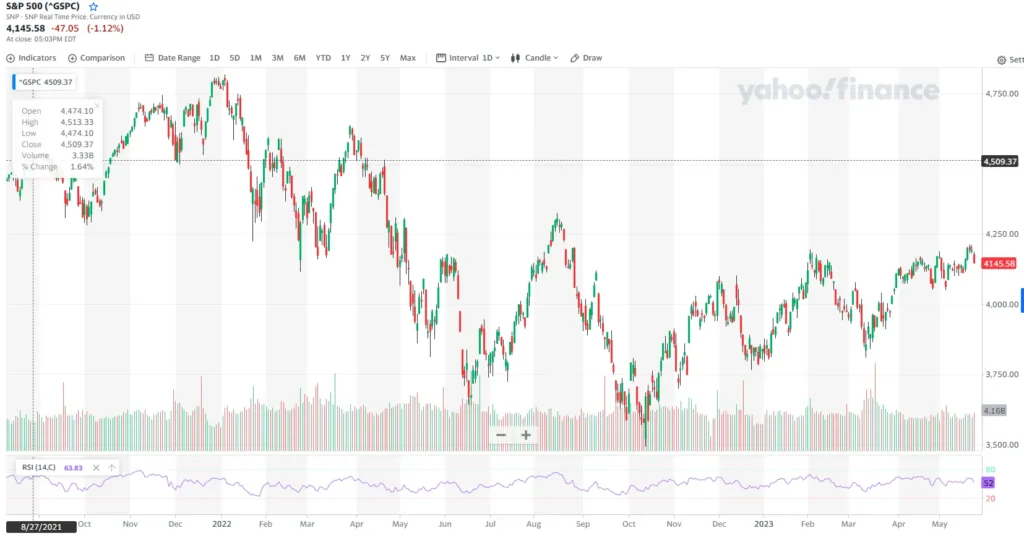Investing in the S&P 500 can be a lucrative and rewarding way to build wealth over time. As one of the most widely recognized stock market indexes, the S&P 500 represents the performance of 500 large-cap U.S. companies.
In this guide, we’ll explore how you can invest in the S&P 500, understand its advantages, and make informed decisions to achieve your financial goals. So, let’s dive into the world of S&P 500 investing and discover the opportunities it offers!
How to Invest in S&P 500
Investing in the S&P 500 is relatively straightforward and offers exposure to a diverse range of companies. Here’s a step-by-step guide on how to invest in the S&P 500:
1. Understand the S&P 500
Before you start investing, it’s essential to understand what the S&P 500 is and how it works. The S&P 500 is an index that tracks the performance of 500 large-cap U.S. companies across various sectors. It is often used as a benchmark to measure the overall health and performance of the U.S. stock market.
2. Open an Investment Account
To invest in the S&P 500, you’ll need to open an investment account. This can be a brokerage account, an individual retirement account (IRA), or a 401(k) account.
Research different financial institutions and choose one that aligns with your investment goals, offers low fees, and provides a user-friendly platform for trading S&P 500 index funds or exchange-traded funds (ETFs).
3. Choose an S&P 500 Index Fund or ETF
To gain exposure to the S&P 500, you can invest in index funds or ETFs that track its performance. These investment vehicles aim to replicate the performance of the index by holding a portfolio of stocks similar to the constituents of the S&P 500. Look for index funds or ETFs with low expense ratios, good track records, and a solid reputation in the industry.
4. Consider Dollar-Cost Averaging
Dollar-cost averaging is an investment strategy that involves regularly investing a fixed amount of money into the S&P 500 over time, regardless of its current price. By doing so, you buy more shares when prices are low and fewer shares when prices are high.
This strategy helps smooth out the impact of short-term market fluctuations and can be an effective way to build a long-term position in the S&P 500.
5. Monitor and Rebalance Your Portfolio
As with any investment, it’s important to monitor your S&P 500 holdings and periodically rebalance your portfolio. Rebalancing involves adjusting your investment allocations to maintain your desired asset allocation and risk level.
Regularly review your portfolio’s performance, assess your financial goals, and make any necessary adjustments to ensure your S&P 500 investment aligns with your long-term strategy.

FAQs about Investing in S&P 500
1. What are the advantages of investing in the S&P 500?
Investing in the S&P 500 offers several advantages. Firstly, it provides exposure to a diversified portfolio of 500 large-cap U.S. companies, reducing the risk associated with investing in individual stocks.
Secondly, the S&P 500 has historically delivered competitive returns over the long term, outperforming many other investment options. Lastly, investing in the S&P 500 is relatively easy and cost-effective, especially through index funds or ETFs.
2. Can I invest in the S&P 500 through my retirement account?
Yes, you can invest in the S&P 500 through retirement accounts such as IRAs and 401(k)s. Many financial institutions offer S&P 500 index funds or ETFs as investment options within these accounts. Investing in the S&P 500 through a retirement account can provide tax advantages and long-term growth potential for your retirement savings.
3. Is it better to invest in an index fund or an ETF for the S&P 500?
Both index funds and ETFs can be suitable options for investing in the S&P 500, and the choice depends on your preferences and investment strategy. Index funds are typically mutual funds that can be bought or sold at the end of the trading day, while ETFs trade like stocks throughout the day.
ETFs may offer more flexibility for active traders, while index funds may be preferable for long-term investors. Consider factors such as expense ratios, liquidity, and trading convenience when making your decision.
4. What is the historical performance of the S&P 500?
The S&P 500 has delivered impressive long-term performance, but it’s important to note that past performance does not guarantee future results. Historically, the S&P 500 has provided an average annual return of around 7-10% over several decades.
However, it’s important to remember that the stock market is subject to volatility, and short-term returns can vary significantly.
5. Can I invest in the S&P 500 if I’m not a U.S. resident?
Yes, non-U.S. residents can invest in the S&P 500 through various financial institutions and brokerage platforms that cater to international investors. However, it’s important to consider any tax implications or restrictions that may apply to your specific country of residence.
Consult with a financial advisor or tax professional familiar with international investing to ensure compliance with applicable regulations.
6. Should I invest solely in the S&P 500 or diversify my portfolio further?
While investing in the S&P 500 can be a solid foundation for a diversified portfolio, it’s generally recommended to further diversify your investments.
Consider adding exposure to other asset classes such as international stocks, bonds, real estate, or alternative investments. Diversification helps reduce risk by spreading your investments across different sectors, geographies, and asset classes.
Conclusion
Investing in the S&P 500 can be a rewarding and accessible way to participate in the growth of the U.S. stock market. By understanding the fundamentals of the S&P 500, choosing the right investment vehicles, and adhering to a long-term strategy, you can position yourself for potential wealth accumulation.
Remember to conduct thorough research, stay informed about market trends, and periodically assess your portfolio to ensure it aligns with your financial goals. With diligence and patience, you can harness the opportunities offered by the S&P 500 and work towards achieving financial success.


